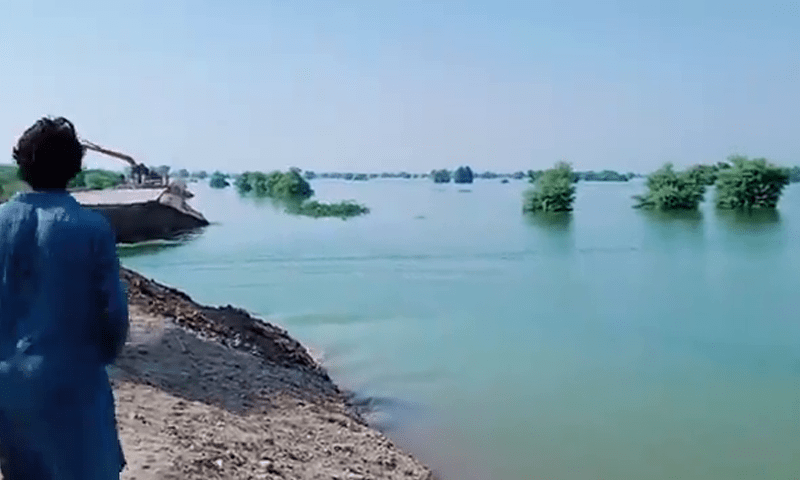On Friday, with the death toll from the weather disaster at 36, two cuttings were made in the Larkana-Sehwan (LS) bund to divert floodwaters from Manchhar Lake and the Main Nara Valley Drain (MNVD) breaches away from Dadu city and its surrounding districts.
The RD-99 and RD-100 cuts were constructed near Karampur city in Sehwan to redirect water from the broken dykes surrounding Manchhar Lake.
Dadu city, Bhan Syedabad, and Sehwan taluka – the constituency of Sindh Chief Minister Murad Ali Shah — were reportedly in danger from water from these cuts.
The cuts were made a few kilometers away from the Danister Wah (channel) of Manchhar Lake, according to Sindh Special Secretary Jamal Mangan.
He explained that the decision was made after officials noticed a decrease in the river’s volume upstream of the Kotri barrage and that this was the only way to speed up the release of water into the River Indus.
Water pressure in cities will be reduced thanks to changes made at LS Bund, and a slight slowdown is being observed today, Mangan said.
The irrigation agency is planning to make another bund cut in the direction of Sehwan’s Tati neighborhood.
Near the Indus Link Canal on the LS bund, floodwaters from the broken MNVD RD-10 and flows from two cuts at Manchhar Lake accumulated.
Manchhar Lake’s protective barrier has been breached twice in the past few days to redirect floodwaters away from the heavily populated cities of Sehwan and Bhan Syedabad.
According to Jamshoro Deputy Commissioner Fareeduddin Mustafa, seven union councils of Sehwan were flooded by the flows from Manchhar Lake, along with the toll plaza, cutting off the taluka from the main part of the Indus Highway and the other districts located along the highway.
He stated that on Wednesday and Thursday, several residents of flood-prone regions including Talti, Bhan Syedabad, Malook Shah, and others were evacuated.
Dadu MNA Rafiq Ahmed Jamali reported that ring bunds had been built in the cities of Mehar and Johi to keep the floodwaters out.
On Friday, upstream and downstream flows were both measured at 199,020 cusecs, indicating that efforts to reduce flows in the Sukkur barrage persisted.
As of 6 a.m, the upstream flow through the Kotri barrage was measured at 604,099 cusecs.
On the other hand, they dropped to 604, 087 cusecs by noon. Discharge downstream of Kotri was measured at 583,282 cusecs.
Mahnur is MS(development Studies)Student at NUST University, completed BS Hons in Eng Literature. Content Writer, Policy analyst, Climate Change specialist, Teacher, HR Recruiter.










